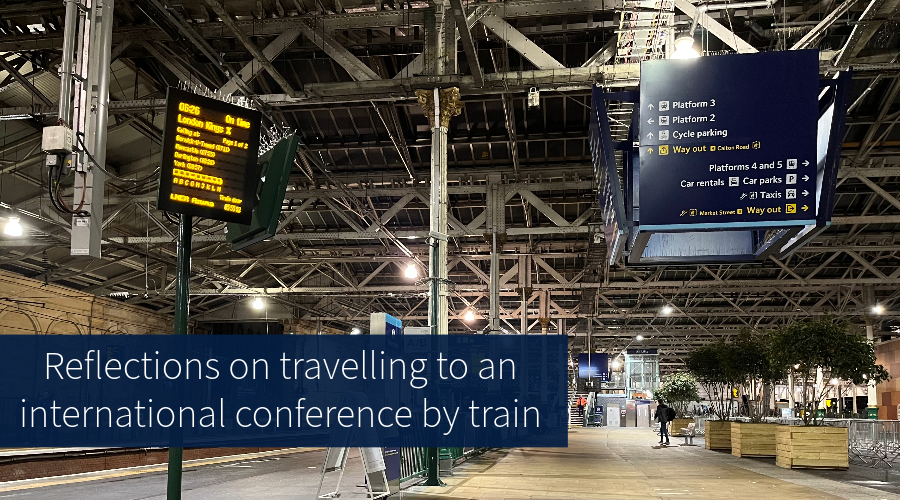From Scotland to Switzerland: Travelling to an international conference by train

Earlier this year Dr James Lamb – lecturer and researcher within the Centre for Research in Digital Education and the Edinburgh Futures Institute – was invited to present at a research conference in Switzerland. James chose to travel to the conference by train, and here shares his experiences and observations of the journey.
After delivering my presentation at Brig in southern Switzerland, my work seemed to land well, although there was some bewilderment that I had made the journey from Edinburgh into the Alps by train. I explained that I was keen to explore whether, in light of the harmful environmental impact of flying, rail offered a viable way of travelling to conferences outside the UK. To help answer this question, I documented my travel experiences, an account of which will be published in next year. Meanwhile, I’m sharing some observations here.
A climate-conscious approach to travel
A bit of personal and professional background before I go any further. I don’t have any special knowledge surrounding climate change, although I do feel a personal responsibility to reckon with the environmental impact of my work. I’m a full-time, permanent lecturer in Digital Education, and within this am expected to develop an international reputation as a researcher. This involves presenting my work at conferences. My teaching and research especially focus on the relationship between learning spaces and digital technologies, something I was keen to explore in the context of transcontinental rail travel.
Compared with the stop-start nature of travelling through and between airports, after taking my seat on each train, I could look forward to an unbroken stretch of several hours to complete particular activities.
A long journey, but no ‘lost’ time

Catching a glimpse of Paris while waiting for a connecting train at Gare de Lyon
Looking across the notes I recorded during my journey, and the calculations I have made since, it’s around 875 miles and 18 hours between Edinburgh Waverley and Bahnhof Brig. Compared with travelling by air, this added an extra day of travel to my combined outbound and return journey. This wasn’t ‘lost’ time, though, as the conditions of the train journey (comfort, light, temperature, table, reasonable Wi-Fi) enabled me to perform the same activities that would have occupied me back in Edinburgh.
This included reviewing a PhD proposal, commenting on student work, discussing teaching matters with colleagues, and polishing the conference materials I would present in Brig. Compared with the stop-start nature of travelling through and between airports, after taking my seat on each train, I could look forward to an unbroken stretch of several hours to complete particular activities.
The itinerary I prepared ahead of travelling points towards the complexity of going by rail. My journey involved connections in London, Paris and Lausanne, which lent anxiety to those moments when incidents north of Darlington and east of Paris caused minor delays. The duration of travel time noted above included gaps to allow for this kind of disruption. For the sake of balance, the longest delays I have ever experienced happened around what were supposed to be direct flights between Edinburgh and other European locations.
Balancing the cost
More difficult to reconcile is the greater cost of my rail journey against what I would have paid for budget flights to Switzerland. My expenses were still within the budget that my hosts in Brig were willing to meet, and I could alternatively have used some of my School-allocated conference funding. However, I won’t always attend events as an invited speaker where expenses are covered, and I appreciate that not everyone has a travel allowance to call on.
At the very least, the cost of rail travel might reduce the number of events that it is possible to attend ‘in person’. For me, this means mixing together online attendance when it is available (and this year I have presented at conferences in Croatia and New Zealand without leaving home), with events that require being physically present.
The cost of rail travel might reduce the number of events that it is possible to attend ‘in person’. For me, this means mixing together online attendance when it is available.
Reflections on rail travel
Other conditions that made the train a straightforward option were my physical health and mobility, and domestic circumstances which meant that I didn’t need to take the quickest route to and from Switzerland. I don’t want to give the impression, though, that my travelling by train was remarkable, especially when colleagues in this and other universities have for some years been attending international events without flying. It also wasn’t a one-off: in recent months I have travelled by rail to a conference in Braunschweig in Germany, while a combination of train and ferry transported me to and from delivering a keynote talk in Dublin.
I can’t capture the entirety of my travel observations here: this is an abridged but honest account of travelling to an international conference by train. It also reflects my experiences during subsequent travel. Despite encountering disruption on each outbound journey, I have generally arrived on time and in a good place to actively participate in the conference. The train carriage has provided a setting conducive to performing the teaching, research and administration that my job involves. On each occasion I could have travelled more cheaply (and harmfully) by air.
Next stop…
Going forward, I expect there will be occasions where geography, time and travel infrastructure will discount the rail option. When that happens, maybe the miles I’ve accrued on the European rail network will give some scope for going by plane. Until then, I’ll keep trying to take the train.
Useful Links
Blog: Covid-19 was horrible – yet we learned that flying less is ok
Sustainability and Social Responsibility
About the author
Dr James Lamb is a lecturer and researcher within the Centre for Research in Digital Education and the Edinburgh Futures Institute. His research and teaching particularly concerns the relationship between learning spaces and digital technologies.





Thanks, James, for spelling out how straightforward – even pleasurable – your conference trip turned out to be! Glad you are writing it up / making it more part of the norm rather than an unusual thing 👌